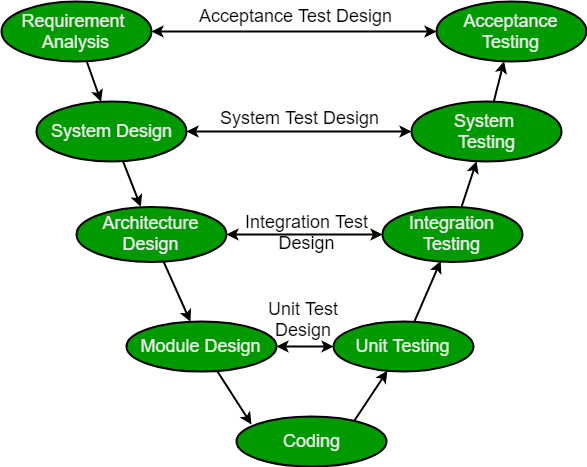SDLC Interview Questions and Answers
Ques 16. Explain when to use the waterfall model.
One should use the waterfall model only when:
- Requirements are very clear and fixed.
- There are no ambiguous requirements.
- Ample resources with required expertise are available freely.
- The client has high confidence in the organization.
- The organization has experience of similar projects.
- The project is short.
Ques 17. Describe V-Shaped software development life cycle model.
The V-shaped SDLC model is an extension of the waterfall model.
The typical waterfall moves linearly downwards, whereas, in the V-shaped model, phases are turned upwards after the coding phase to form the V shape. It demonstrates the relationship between each phase of SDLC and its respective testing phase. Unlike the waterfall model, the V-Shape includes early test planning.

Ques 18. Briefly describe the phases in the V-Shaped model.
Phases in V-Shaped model:
Verification phases are on the left side of the V-shape. It consists of:
Requirements analysis: Requirements are gathered and analysis is performed to understand the problem and propose a solution.
System Design: Engineers analyze the requirements gathered and propose ways the system can be created or built from a feasibility point of view.
Architecture design: Architecture of the system is designed consisting of various modules, depicting their relationships and communication between them.
Module design: This is a low level design where modules are designed individually and in a detailed manner.
Coding: This is at the bottom of the V-Shape model. Module design is converted into code by developers.
Validation phases are on the right side of the V-shape. It consists of:
Unit testing: Testing by analysis of the code by developers for their independent modules is done.
Integration testing: Independent modules are tested together to validate interface and expose errors in them.
System testing: The system is tested against the system specifications.
User Acceptance testing: Testing is performed by end users to validate that the requirements mentioned in requirements phase have been met by the system or not before accepting it for production.
Ques 19. Explain the strengths of the V-Shaped model.
Strengths of V-Shaped model:
a) Simple and easy to use model.
b) Every phase has clear and fixed deliverables.
c) Higher chances of success as test planning starts early in the SDLC cycle.
d) Quickest for project where requirements are fixed and clearly defined.
Ques 20. Explain the weaknesses of the V-Shaped model.
Weaknesses of V-Shaped model:
a) It is inflexible.
b) Changes in requirements are very hard to accommodate
c) No early prototypes are available
d) Needs ample skilled resources.
Most helpful rated by users:
- What is Software Life Cycle?
- What are the different phases in SDLC?
- Why is software development life cycle important?
- What is SDLC model? What are the most well known SDLC models?
- Describe waterfall software development life cycle model.
